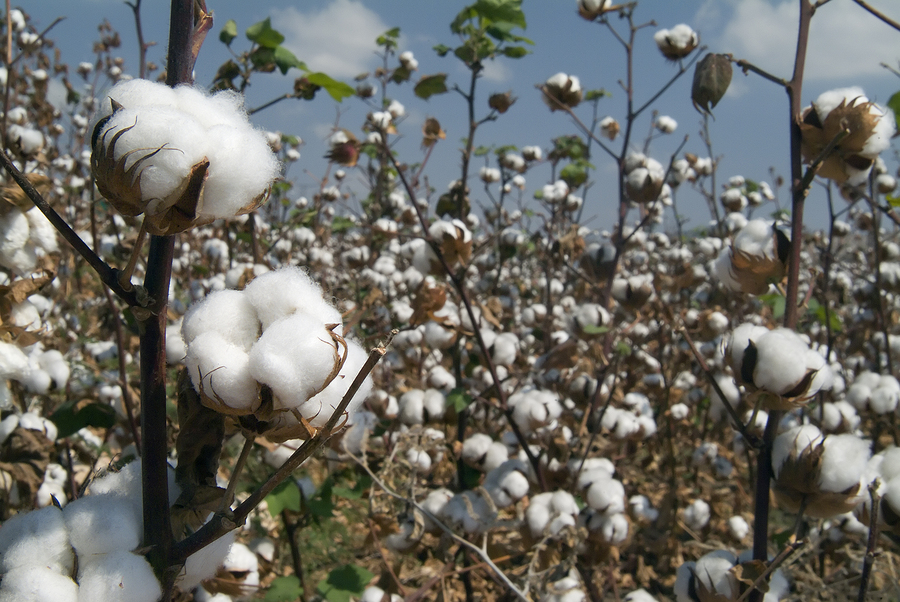US FDA (Food and Drug Administration) regulators have approved a new type of GM cotton, the seed of which is to be used for human and animal consumption. The cotton, developed by researchers at Texas A&M University, is being touted as a protein-rich way to feed the poor and hungry. However, the many risks of this GM food are being ignored.
The GM cotton is engineered to have lower than normal levels of a substance called gossypol in the seed, but normal levels in other parts of the plant. Gossypol is useful to the plant for resisting pests and diseases, but it is toxic for humans and animals (though less so to mature ruminants such as cows) to eat.
RNAi effects
The new GM cotton was produced using a GM approach called RNAi, which is short for RNA interference. RNAi essentially results in the silencing of expression of a desired gene or genes. This particular application of RNAi-mediated gene silencing was intended to reduce production of gossypol in the seeds.
The risks of GM RNAi crops have been described in a review by a team of international scientists. The main concern is that the RNAi molecules in our food plants can survive digestion and enter the body of the human or animal consumer.
RELATED STORY:
One study found that these molecules can affect the expression of the genes of the consumer, with unpredictable effects. This research study was in non-GM plants, but the findings will apply to plants in general, whether they are GM or not.
Other potential effects of using RNAi to engineer crop plants include unintended gene silencing in the GM plant, or unintended knock-on effects of the intended gene silencing. At present these effects are difficult if not impossible to predict.
As for the developer’s attempts to confine the activity of the RNAi to the seeds, these may prove unreliable, as Prof Jack Heinemann noted in a 2012 paper on GM RNAi wheat, where the gene silencing effect was intended only to affect the endosperm (tissue inside the seeds). Prof Heinemann noted: “Importantly… RNAi can be transmitted across plant tissues regardless of where the interference is initially generated… This means that the introduced siRNAs [short inhibitory RNA, a type of RNA molecule that causes RNA interference] may not be confined to the intended tissue (e.g., endosperm) and that the entire plant needs to be used for testing toxicity to indicator birds, mammals, insects and nematodes.”
Prof Heinemann and co-authors wrote a peer-reviewed paper in which they concluded that “regulatory bodies are not adequately assessing the risks” of GM RNAi products. Certainly the FDA has failed to do so in the case of the new GM cotton.
RELATED STORY:
Contraceptive
Research has proven gossypol to be an effective male contraceptive, to such an extent that it has been put forward as an alternative to vasectomy. The main problem is that the infertility induced by the substance is not reversible in around 50% of men.
Given the unpredictability of GM technology, levels of gossypol in the seeds of some GM cotton plants could unexpectedly prove to be higher than intended, resulting in people and animals eating a toxic and contraceptive substance.
Antibiotic resistance marker gene
The new GM cotton, called TAM66274, also contains a gene to express a protein, NPTII, which confers resistance to several antibiotics. This is a remnant from the GM transformation process, in which NPTII was used as a marker gene in the generation of the GM cotton, so that the genetic engineers could select for cells that had successfully taken up the RNAi transgene conferring the low gossypol trait.
There are health concerns around antibiotic marker genes in GM crops. These genes could transfer to pathogenic bacteria, making them antibiotic resistant.
RELATED STORY:
Toxicity not tested
Judging by the FDA summary of the application from Texas A&M University, no toxicity testing in animals has been done on the seeds that are intended for consumption. The application only refers to testing in mice of the NPTII antibiotic resistance gene product, though it does not mention how long the tests lasted. It’s almost certain that long-term effects were not tested for.
In addition, the substance tested was the NPTII protein as expressed in E. coli bacteria, not as expressed in the actual GM cotton. This is inadequate due to a phenomenon known as post-translational modification, which means that a protein can be different from its original form when it is expressed in a new genetically engineered organism. Specifically, it could change in a way that makes it toxic or allergenic.
For compositional components other than gossypol, Texas A&M conducted a typically superficial compositional analysis to ascertain levels of certain components (e.g. protein, fat, carbohydrate, amino acids, selected vitamins and minerals). They reported statistically significant differences between GM TAM66274 cotton and non-GM parent variety control cottonseeds in the levels of 16 components for samples collected in 2014, and 20 components for samples collected in 2015.
These differences show clearly that this GM cotton is NOT substantially equivalent to non-GM cotton. However, Texas A&M noted that the values for these components in TAM66274 cotton fell within the range of values in the ILSI (industry-funded) database and scientific literature.
But there are problems with this approach.
RELATED STORY:
First, the only valid comparator in this type of compositional analysis is the non-GM cultivar grown at the same time and location – and this showed major differences between GM TAM66274 cotton seeds and its non-GM parent. Comparisons with historical values present in the ILSI database are not valid as they can lead to spurious conclusions.
Second, some components may be present in some types of cotton at levels that are actually unsafe, but because this has never been tested, no one will be able to predict harmful effects from eating those components at these levels in the GM cotton.
Importantly, the fact that this gross compositional analysis revealed that many components were present at statistically different levels in the GM TAM66274 cottonseeds implies that the GM transformation process had resulted in unexpected DNA mutations, leading to alterations in gene function and thus plant biochemistry. This strongly argues for the need of a more in-depth compositional analysis using state-of-the-art molecular profiling (“omics”) methods to reveal the true extent of the GM transformation-induced mutations and what their health consequences might be.
Furthermore, although cottonseed oil has been used for culinary purposes for many years, whole cottonseeds have never been an integral part of the human diet due to their gossypol content. Thus it is not known whether the GM cottonseeds will actually be safe to eat, even if gossypol levels have been reduced to a presumed safe level. Individuals may still experience adverse reactions (e.g. allergies) to other components still present in the seeds.
In addition, unpredictable alterations to the cotton plant’s biochemistry, arising from the mutagenic effects of the GM transformation process and leading to the production of novel toxins or allergens, cannot be excluded.
Given these uncertainties, long-term controlled laboratory animal toxicity feeding studies are required for this product, but have not been carried out.
RELATED STORY:
Poor and malnourished people targeted
The developers are talking in terms of this plant helping to solve global malnutrition, which suggests that apart from the most obvious destination as animal feed, the intention is to target poor and malnourished people.
The risks described above raise questions as to why this potentially unsafe GM crop is being pushed as a solution to hunger at the expense of other non-GM protein-rich plants that have a long history of safe use in feeding people, such as pulses and seeds.
*Article originally appeared at Organic Consumers Association. Reposted with permission.












